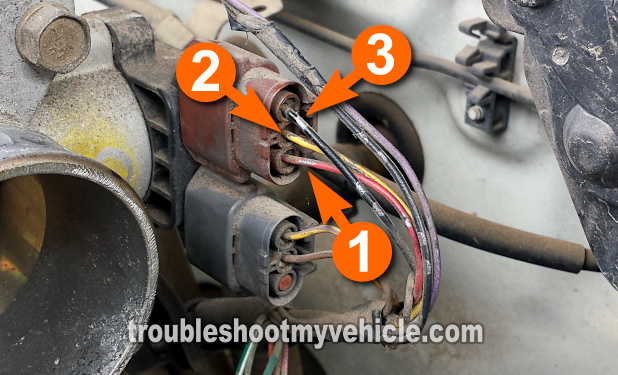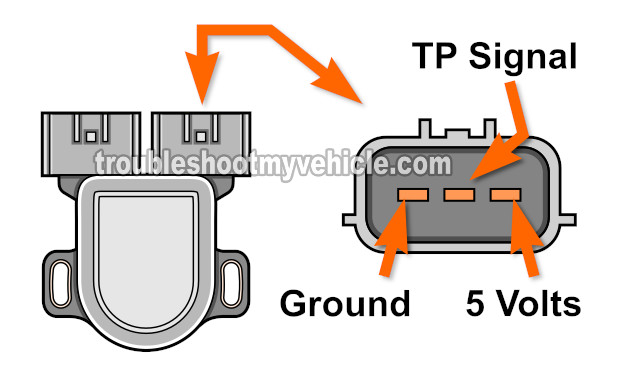
As you probably already know, the TP sensor on the 2000-2002 1.8L Nissan Sentra has two connectors. This is because the TP sensor contains two sensors in the same assembly.
One part of the TPS assembly is an idle switch and the other part is the throttle position sensor.
In this tutorial, I'll show you how to test the throttle position sensor part with a multimeter (you don't need a scan tool). Moreover, you don't need to remove the TPS assembly from the throttle body to test it.
Contents of this tutorial:
ES ![]() You can find this tutorial in Spanish here: Cómo Probar El Sensor TPS (2000-2002 Nissan 1.8L Sentra) (at: autotecnico-online.com).
You can find this tutorial in Spanish here: Cómo Probar El Sensor TPS (2000-2002 Nissan 1.8L Sentra) (at: autotecnico-online.com).
APPLIES TO: This tutorial applies to the following vehicles:
- 1.8L Nissan Sentra: 2000, 2001, 2002.
Symptoms Of A Bad Throttle Position Sensor
The function of the TPS sensor is to let your Nissan Sentra's fuel injection computer know how far the throttle opens or closes when you press or release the accelerator pedal.
This throttle angle information (and that of other fuel and ignition system input sensors) allows the fuel injection computer to inject more or less fuel into the engine.
As the TPS is a critical engine management sensor, if it fails, you'll see one or more of the following trouble codes:
- P0122: Throttle Position Sensor Circuit Low Input.
- P0123: Throttle Position Sensor Circuit High Input.
- P1121: Throttle Position Sensor Signal Lower Than Expected.
- P1122: Throttle Position Sensor Signal Higher Than Expected.
Throttle Position Sensor Circuit Descriptions
In order to diagnose the TP sensor, we need to know which wires of the brown TPS connector on the engine harness give it power and Ground. We also need to know which wire carries the TPS signal to the fuel injection computer.
Here's a brief description of the 3 TPS circuits (wires):
| TPS Circuits (2000, 2001, 2002 1.8L Nissan Sentra) | ||
|---|---|---|
| Terminal | Wire | Description |
| 1 | red (RED) | 5 Volts |
| 2 | yellow (YEL) | Throttle Position Signal |
| 3 | black (BLK) | Ground |
TEST 1: Testing The TPS Voltage Signal

In order to successfully diagnose the TP sensor on your 1.8L Nissan Sentra, you need to know the following:
- The TPS sensor generates a signal in Volts DC, and this voltage increases as the throttle plate opens.
- The voltage value (when the throttle plate is wide open) returns to its closed throttle value as soon as the throttle plate closes to its rest position.
The cool thing is that you can use a multimeter to check how the voltage increases and decreases as the throttle opens and closes.
If the TP sensor is defective, the TPS voltage signal will remain fixed at a single value. In other words, the voltage value will not increase/decrease as the throttle opens/closes.
NOTE: The TPS on your Nissan Sentra has a brown and a gray connector. The brown connector belongs to the TPS. The gray connector is for the idle switch portion of the TPS assembly.
IMPORTANT: This test is performed with the TP sensor mounted in its place on the throttle body and connected to its connector. You don't have to remove it to bench test it. Also, you must use a wire piercing probe or a back probe to measure the TP signal voltage. To see what a wire piercing probe looks like go here: Wire Piercing Probe.
Here are the steps:
- 1
Place your multimeter in Volts DC mode.
- 2
Connect the red multimeter test lead to the middle wire of the sensor's brown connector.
This is the wire labeled with the number 2 in the photo above. - 3
Ground the black multimeter test lead on the battery negative (-) terminal.
- 4
Have your helper turn the key to the ON position, but don't start the engine (this will power up the TP sensor).
- 5
Your multimeter should report a voltage between 0.2 to 0.9 Volts DC.
If your multimeter doesn't, don't worry about it just yet, continue with the other steps.
Part 2
- 6
Slowly open the throttle (by hand and from the engine compartment) while you observe the change in voltage numbers on your multimeter.
As the throttle opens, the voltage numbers should increase.
Once the throttle is wide open, your multimeter should read somewhere between 3.5 to 4.5 Volts DC.
NOTE: For this test result to be accurate, you need to open the throttle by hand and not from inside the vehicle. - 7
Slowly close the throttle.
As the throttle plate closes, the voltage numbers should decrease to the exact same voltage you noticed in step 5.
Part 3
- 8
Lightly tap on the throttle position sensor with the handle of a screw-driver or something similar.
I want to emphasize the words 'lightly tap' as you slowly open and close the throttle and observe the multimeter.
If the TPS is bad, the tapping will cause the voltage numbers to skip or go blank. If the TPS is OK, the tapping will have no effect on the voltage numbers. - 9
Repeat step 8 several times to make sure of your multimeter test results.
Let's take a look at your test results:
CASE 1: The throttle angle voltage increased/decreased as you opened/closed the throttle plate. This test result confirms that the TP sensor is OK and not defective.
CASE 2: The throttle angle voltage DID NOT increase/decrease as you opened/closed the throttle plate. This test confirms a problem with the throttle position sensor on your 2000-2002 1.8L Nissan Sentra.
If I where in your shoes and to make sure that the TPS really has failed, I would still make sure that the TP sensor gets both power and Ground. For the first of these two tests, go to: TEST 2: Making Sure The TPS Is Getting 5 Volts.
CASE 3: The multimeter DID NOT register any voltage. This test result doesn't condemn the TP sensor as bad just yet.
Why? Because the TP sensor may be missing either power or Ground. So the next step is to check that the TP sensor is getting power, go to: TEST 2: Making Sure The TPS Is Getting 5 Volts.

